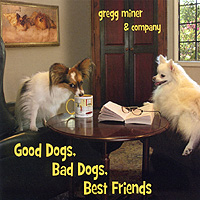 Guitarist
and recording artist Gregg Miner heads up the Harp Guitar Music
recording company. As a prime exponent of the harp guitar in the 21st
century, Miner is a master in the recording studio and, as he’s
proven in the past, he knows how to record the guitar and harp guitar
to get maximum depth in the sound spectrum. For guitar lovers unaware
of the harp guitar, it’s basically a six string acoustic with
additional ‘floating’ harp like strings adding more range
and depth to the guitar sound. With a number of intriguing instrumental
CDs, each featuring the exotic looking and sublime sounding harp guitar,
already in the Harp Guitar Music catalog, the label’s late ‘09
releases includes the third CD from French harp guitar sensation Philippe
Fouquet entitled Turning Point. For his 2009
CD, Fouquet has written thirteen tracks that place him in the melodic
realm of outstanding guitarists. Fouquet’s guitar technique and
mastery of the compositional aspect of the guitar is well detailed
on this superb release. Miner’s own 2009 CD from his Gregg
Miner & Company, Good Dogs, Bad Dogs, Best Friends has
hilarious cover art. Miner’s blend of instrumental acoustic guitar
music has a touch of humor in it but make no mistake, this is serious
musical business and Miner is a well respected name among the finest
harp guitar players on the planet today.
Guitarist
and recording artist Gregg Miner heads up the Harp Guitar Music
recording company. As a prime exponent of the harp guitar in the 21st
century, Miner is a master in the recording studio and, as he’s
proven in the past, he knows how to record the guitar and harp guitar
to get maximum depth in the sound spectrum. For guitar lovers unaware
of the harp guitar, it’s basically a six string acoustic with
additional ‘floating’ harp like strings adding more range
and depth to the guitar sound. With a number of intriguing instrumental
CDs, each featuring the exotic looking and sublime sounding harp guitar,
already in the Harp Guitar Music catalog, the label’s late ‘09
releases includes the third CD from French harp guitar sensation Philippe
Fouquet entitled Turning Point. For his 2009
CD, Fouquet has written thirteen tracks that place him in the melodic
realm of outstanding guitarists. Fouquet’s guitar technique and
mastery of the compositional aspect of the guitar is well detailed
on this superb release. Miner’s own 2009 CD from his Gregg
Miner & Company, Good Dogs, Bad Dogs, Best Friends has
hilarious cover art. Miner’s blend of instrumental acoustic guitar
music has a touch of humor in it but make no mistake, this is serious
musical business and Miner is a well respected name among the finest
harp guitar players on the planet today.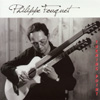 With those two fun loving dogs on the cover art, Good Dogs, Bad
Dogs, Best Friends CD was conceived as sixteen tracks of instrumental
musical snapshots by Miner and his pooch loving guitar buddies. The
colorful CD booklet is really great with its in depth dog tales and
touching pics. Track for track Miner has truly constructed possibly
the first all instrumental multi-artist harp guitar collection, all
dedicated to man’s best friend. A portion of CD’s sales
goes to www.SearchDogFoundation.org
Also released in 2009 by Harp Guitar Music is Case Closed from
Canadian harp guitar master Carter Lancaster.
With those two fun loving dogs on the cover art, Good Dogs, Bad
Dogs, Best Friends CD was conceived as sixteen tracks of instrumental
musical snapshots by Miner and his pooch loving guitar buddies. The
colorful CD booklet is really great with its in depth dog tales and
touching pics. Track for track Miner has truly constructed possibly
the first all instrumental multi-artist harp guitar collection, all
dedicated to man’s best friend. A portion of CD’s sales
goes to www.SearchDogFoundation.org
Also released in 2009 by Harp Guitar Music is Case Closed from
Canadian harp guitar master Carter Lancaster.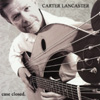 Just one look at Carter on the CD cover art with that wild looking
harp guitar an you just know he means business. Lancaster’s second
solo album, and the first to feature his harp guitar compositions,
Case Closed features a wealth of original guitar instrumentals,
with many tracks crafted and created for harpguitar and six string
steel string acoustic guitar. Lancaster’s original songs are
inventive and each receive the royal treatment on his classic guitars.
Another CD release on the Harp Guitar label sure to pick up interest
in 2010 is a fascinating release from a piano man named Brad Hoyt,
entitled Together Alone. Subtitled Duets
With Piano And Harp Guitar, the fourteen track CD features
Brad Hoyt on various pianos performing original music in duet form
with some of the finest exponents of the harp guitar including the
album’s co-producer Gregg Miner, Carter Lancaster, Antoine
Dufour, Jeff Titus, Mike Doolin, Stacy Hobbs,
Muriel Anderson, John Doan, Don Alder and Pete
Bradshaw. Although he’s the piano player, Hoyt himself takes
the spotlight performing both piano and harp guitar on the CD closing
“Sheechka Moye.” Guitar fans and piano fans will marvel
at the amazing talent and technique of Hoyt and his gifted harp guitar
players, yet the real star on Together Alone is Hoyt’s
sublime compositions, which combine a number of classical, jazz and
slightly shaded New Age / Americana motifs in his instrumental originals.
The CD booklet features liner notes by Hoyt and Miner while track
by track liner notes here feature information on the many fine instruments
on the recording—instruments that pair Hoyt’s immaculate
sounding Steinway D piano with harp guitars with names like Noble
harp guitar, the Carlson “Oracle” harp sympitar (with its
ethereal sitar like effect), the Doolin jazz harp guitar, the Doolin
harp requinto, the Sullivan-Elliot 20-string harp guitar, the Zimmerman
harp guitar, the Knutsen harp mandolin, the Dyer harp guitar, Spillers
harp guitar, the Gibson harp guitar, the Wingert harp guitar and last
but not least, the Sedgwick 30-string arpa viola Caipira, a Brazilian
harp country guitar that’s played by Hoyt, dueting with himself
on the glorious sounding tack piano on the aforementioned set closing
track.
Just one look at Carter on the CD cover art with that wild looking
harp guitar an you just know he means business. Lancaster’s second
solo album, and the first to feature his harp guitar compositions,
Case Closed features a wealth of original guitar instrumentals,
with many tracks crafted and created for harpguitar and six string
steel string acoustic guitar. Lancaster’s original songs are
inventive and each receive the royal treatment on his classic guitars.
Another CD release on the Harp Guitar label sure to pick up interest
in 2010 is a fascinating release from a piano man named Brad Hoyt,
entitled Together Alone. Subtitled Duets
With Piano And Harp Guitar, the fourteen track CD features
Brad Hoyt on various pianos performing original music in duet form
with some of the finest exponents of the harp guitar including the
album’s co-producer Gregg Miner, Carter Lancaster, Antoine
Dufour, Jeff Titus, Mike Doolin, Stacy Hobbs,
Muriel Anderson, John Doan, Don Alder and Pete
Bradshaw. Although he’s the piano player, Hoyt himself takes
the spotlight performing both piano and harp guitar on the CD closing
“Sheechka Moye.” Guitar fans and piano fans will marvel
at the amazing talent and technique of Hoyt and his gifted harp guitar
players, yet the real star on Together Alone is Hoyt’s
sublime compositions, which combine a number of classical, jazz and
slightly shaded New Age / Americana motifs in his instrumental originals.
The CD booklet features liner notes by Hoyt and Miner while track
by track liner notes here feature information on the many fine instruments
on the recording—instruments that pair Hoyt’s immaculate
sounding Steinway D piano with harp guitars with names like Noble
harp guitar, the Carlson “Oracle” harp sympitar (with its
ethereal sitar like effect), the Doolin jazz harp guitar, the Doolin
harp requinto, the Sullivan-Elliot 20-string harp guitar, the Zimmerman
harp guitar, the Knutsen harp mandolin, the Dyer harp guitar, Spillers
harp guitar, the Gibson harp guitar, the Wingert harp guitar and last
but not least, the Sedgwick 30-string arpa viola Caipira, a Brazilian
harp country guitar that’s played by Hoyt, dueting with himself
on the glorious sounding tack piano on the aforementioned set closing
track. As a side note, way back in 1986, I released an now classic CD of
all instrumental music on my then Breakthru’ Records label from
the brilliant Swedish pianist Stefan Nilsson entitled Romantic
Piano Dreams, which featured Stefan on Steinway performing all
instrumental original piano solos. That CD wasn’t classical,
it wasn’t pop, it wasn’t New Age, but rather a combination
of all. Since the release of that CD, this writer hasn’t heard
a piano based album that conjures up that same sense of ethereal keyboard
wonder as well as Hoyt’s Together Alone. Looking back
in time, Brad Hoyt’s Together Alone is just as fascinating
as Stefan Nilsson’s now classic CD—plus along with Hoyt's
piano sound you get to hear some of the greatest harp guitarists of
the modern musical era. Now that’s what I call a great deal!
Perhaps the one thing these four CD’s, released on the Harp Guitar
Music label, have in common is a focused attention to musical composition,
state of the art recording techniques, in depth annotation of each
player here, prominent CD design and packaging and a splendid devotion
to the art and craft of the guitar, specifically the captivating sound
of the heavenly harp guitar.
As a side note, way back in 1986, I released an now classic CD of
all instrumental music on my then Breakthru’ Records label from
the brilliant Swedish pianist Stefan Nilsson entitled Romantic
Piano Dreams, which featured Stefan on Steinway performing all
instrumental original piano solos. That CD wasn’t classical,
it wasn’t pop, it wasn’t New Age, but rather a combination
of all. Since the release of that CD, this writer hasn’t heard
a piano based album that conjures up that same sense of ethereal keyboard
wonder as well as Hoyt’s Together Alone. Looking back
in time, Brad Hoyt’s Together Alone is just as fascinating
as Stefan Nilsson’s now classic CD—plus along with Hoyt's
piano sound you get to hear some of the greatest harp guitarists of
the modern musical era. Now that’s what I call a great deal!
Perhaps the one thing these four CD’s, released on the Harp Guitar
Music label, have in common is a focused attention to musical composition,
state of the art recording techniques, in depth annotation of each
player here, prominent CD design and packaging and a splendid devotion
to the art and craft of the guitar, specifically the captivating sound
of the heavenly harp guitar.
MWE3.com speaks to GREGG MINER
Tell us something about your musical background and how long
you’ve been playing guitar and any other instruments as well.
Robert, if you’ve seen my 1995 CD set A Christmas Collection
you’ll believe me when I say that my musical background would
fill a book. That project featured every single instrument I owned
at the time, each played once. About a hundred mostly plucked strings—that
by now were assembled into “The Miner Museum of Vintage, Exotic
& Just Plain Unusual Musical Instruments.” We’ll have
to skip over that, I think!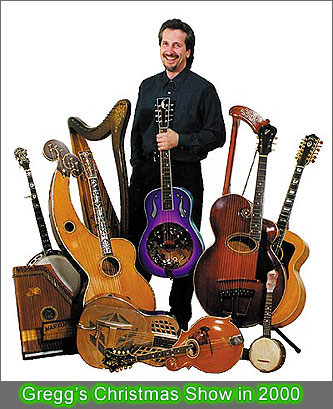
I did start with the guitar, as we all did I suppose, sometime
during grade school. Played a Black Beauty Les Paul in the obligatory
high school basement rock band (daily rehearsals, no gigs). We also
had our “folk guitars” and were doing Crosby, Stills &
Nash and similar guitar-based music. We weren’t aware of instrumental
music per se until later on when I discovered Leo Kottke, and finally
started paying attention to this whole rich world I had been ignorant
of—Chet Atkins, Django Reinhardt, classical guitar, blues, jazz,
early “world” (remember Ralph Towner?), fusion, you-name-it.
Embarrassing, I know—but this was an era (late ‘60s) where
we Chicago suburbians shopped for albums at Sears. I remember
discovering the brand new Mountain and Black Sabbath in those bins!.
Beyond that it was random word of mouth.
With no specific plans, I hung out at home, worked part time, and
took classical and jazz guitar lessons in Chicago once a week. My
bedroom was filled with reptiles, guitars, Roger Dean and Tolkien
posters, and a TEAC 3340.
About 1976 (age 21), my girlfriend stole me away to an Illinois college
town for 3 years. There, I started working on my own steel-string
fingerstyle guitar technique, adapted from stumbling through Kottke
tunes, and especially from learning new hero Dave Evans’ entire
Kicking Mule Sad Pig Dance album. I rarely played solo, but
layered onto my home recordings various other instruments I had randomly
picked up—the beginnings of what would become “the Museum.”
How did you become introduced and what attracted you to playing
the harp guitar and how would you describe the main differences between
the acoustic steel string and the harp guitar?
As I recall, it was the discovery of Baines’ infamous book, “American
& European Musical Instruments,” which our library had a
copy of. It was Disneyland for a guitar/instrument lover. I probably
kept it on permanent loan and would drool endlessly over these incredible
“exotic” instruments—arch-citterns, harpolyres, harp-lutes,
and on and on!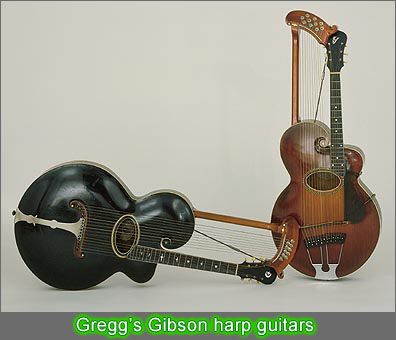 More specifically, the Michigan Ave. 6-story building where I took
lessons had the “Guitar Gallery” on the 3rd floor—where,
hanging behind the counter was a black Gibson harp guitar—to
this day unsurpassed in aesthetics, as far as I’m concerned.
I would stop off at their floor once a week after lessons and just
stare at that thing, imagining a fantasy future where I would actually
find and own one myself—an impossible dream at the time!
More specifically, the Michigan Ave. 6-story building where I took
lessons had the “Guitar Gallery” on the 3rd floor—where,
hanging behind the counter was a black Gibson harp guitar—to
this day unsurpassed in aesthetics, as far as I’m concerned.
I would stop off at their floor once a week after lessons and just
stare at that thing, imagining a fantasy future where I would actually
find and own one myself—an impossible dream at the time!
In 1983, now in Los Angeles (another long story), I finally got my
first harp guitar—a red Gibson Style U! It was $1500, which I
put on my Visa line of credit and paid off for 2 years, whilst eating
Kraft macaroni & cheese. It was and is—terrible for fingerstyle
guitar, but I used it for “authenticity” in the Los Angeles
Mandolin Orchestra, where I played mandocello for some time. Other
than that, it was just a spectacular wall-hanger. The Gibson, and
later, Knutsen and other harp guitars, were still just “another
unusual stringed instrument” that I would pick up when I was
able to stumble on something affordable. I didn’t truly play
one until the Christmas project, when they were part of the “roster”
– meaning; now I had to play them!An aside: Ironically,
at the exact moment Michael Hedges was making history with his Dyer
(late ‘80s), I was virtually ignorant as I was concentrating
almost exclusively on the concert harp, at the time my main instrument
and theoretical future.
So I guess I’m one of the few players who wasn’t
influenced by either Hedges or Stephen Bennett (and now a plethora
of active harp guitarists). I was attracted to playing it for the
same reason as for any of the lutes, zithers and stranger things in
the growing collection. They were indescribable, irresistible, intoxicating
mysteries of invention, art, history, music and sound to explore.
As far as comparing the “modern” harp guitar (strangely
enough, a vintage Dyer or copy) to an acoustic 6-string, there
are various ways players utilize the extra strings, both technically
and musically (Hedges uses them in his famous “Because It’s
There” essentially backwards). My tendency immediately
developed towards using the subs as a way to open up the voicings
one might otherwise play on the neck—to not only lower them,
but expand them. So much so that I can no longer find my way around
a 6-string! Another advantage—especially when in an open tuning,
like I usually am—is sustain and overlapping notes. My Christmas
album solo “Bring a Torch, Jeanette, Isabella” is perhaps
an extreme example—I think it uses a couple thousand open strings
(neck and subs) and a handful of fretted ones! One of the most magical
effects on the harp guitar, which most players eventually discover,
is playing harmonics on the subs—that’s reason enough
to spend any amount of money to acquire a great instrument.
How about the stringing challenges required for the harp guitar?
What strings do you prefer and does the harp guitar present any recording
challenges?
That may be the one and only drawback—that proper strings don’t
yet exist. I’ve been operating my web store Harp Guitar Music—where,
among other things—I offer strings, since 2006; and I still
haven’t found a string manufacturer willing to produce the gauges
and/or materials that dozens of players actually require (at least
affordably).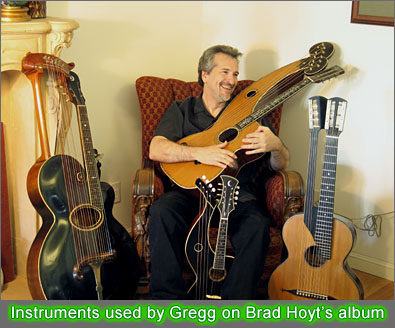 As we speak, many amateur and professional harp guitarists are using
strings that may be a poor compromise. But this situation will soon
be improving, one way or another, I can promise you. Regardless of
the gauge situation, another inherent problem is vibrating string
length—and thus the specifics of manufacturing each gauge. You
need double, and even triple, wound strings (I’m talking
phosphor bronze) as you get into the lower notes. The problem is that
both historical and modern custom harp guitars come with every conceivable
scale length for each individual sub! With these strings, one can’t
simply snip to length and use—many a player has spent ten dollars
on a single string only to watch it go “sproing”
from attempting to get through their tuner post.
As we speak, many amateur and professional harp guitarists are using
strings that may be a poor compromise. But this situation will soon
be improving, one way or another, I can promise you. Regardless of
the gauge situation, another inherent problem is vibrating string
length—and thus the specifics of manufacturing each gauge. You
need double, and even triple, wound strings (I’m talking
phosphor bronze) as you get into the lower notes. The problem is that
both historical and modern custom harp guitars come with every conceivable
scale length for each individual sub! With these strings, one can’t
simply snip to length and use—many a player has spent ten dollars
on a single string only to watch it go “sproing”
from attempting to get through their tuner post.
As for preferred strings, do you mean “type” or “brand”?
I have instruments strung with both nylon (basses are nylon overspun
with silver-plated copper) and steel (phosphor bronze). Nearly all
my personal music is played on Dyer-style steel-string instruments,
the brand being largely unimportant—again, with the gauge problem,
we are often mixing available D’Addario and John Pearse strings
on our subs out of necessity, for example. Other modern players might
use all nylon (Muriel Anderson) or a mixture (John Doan with Elixir
steels on the neck, but nylon LaBella subs). The missing piece of
the puzzle—and tops on my “want list” whenever I do
find that manufacturer—is something in between: Silk & Bronze
subs. This would be the modern equivalent of historical strings used
on every “originally strung” Knutsen or Dyer we have found.
They would be about eighty percent the tone of PB—a bit softer—and
less tension, and I think the most requested string out there,
if I can get them produced!
Tell us something about some of your favorite guitars and the
harp guitars and other guitars featured on your latest album.
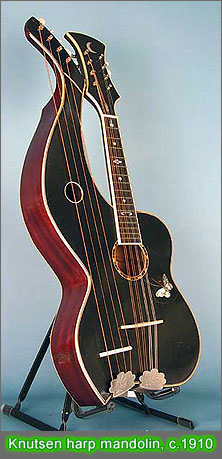 My favorite
6-string is in mothballs: my totally beat up but cannon-like 1928
Martin 0-28 (heard on my Christmas album).Like I said, 6-strings now
confuse me! Favorite harp guitar—for playing and listening to,
is the vintage Dyer, in this case a Style 8. That would be my main
harp guitar. I was a hundred percent vintage-only guy—even a
snob—until I started hearing some of the modern instruments.
When I got a certain 2007 Merrill harp guitar for the business, it
sold immediately, but I begged the buyer to let me keep it for a month
to record with. One of those pieces is on the new album (the tune
“Jasta” on Good Dogs, Bad Dogs, Best Friends). It’s
like having a “new” Dyer, one advantage being easier to
record, as the balance and overtones are more controlled. And of course,
there are no pesky intonation problems or other neck/fret imperfections.
I’ve now ordered a couple—to sell, and maybe to keep one!
There is actually one harp guitar that blows away the Dyer, and that
is my particular Knutsen Symphony Harp Guitar, pre-1900. It is notoriously
difficult to record as the overtones are so prevalent you hear assorted
super-high specific chromatic harmonics as you play various notes.
Live, however, it is a miracle—wild and wooly, an explosion of
wood and air—and every pro guitarist who visits the museum says
it’s their favorite instrument. It’s on Beyond Six Strings,
our inaugural release, but not recorded to do it justice. I don’t
know if it can be captured. I did use another cool Knutsen,
recently restored, on the new album: it’s one of his three-quarter
harp guitars—in his case, truly three-quarter: the scale length
of the neck is 19-1/4”! With subs proportional or a bit longer.
So naturally, I tuned it up a third higher, and it is very
interesting! I could have gone a fourth higher, but was losing sustain
on the high melody, essential to the tune “Mickey,” about
our little runt Papillon. Oh, and I also played one of my Knutsen
“true” harp mandolins; true in the sense that it has 4 sub-basses!
These I found to make no musical sense whatsoever in any traditional
mandolin way, but they’re great fun to play fingerstyle, which
is what I did, in a duet with a harp. I used it again—fingerstyle,
with a plectrum solo—on one of my duets with pianist Brad Hoyt
on his new CD.
My favorite
6-string is in mothballs: my totally beat up but cannon-like 1928
Martin 0-28 (heard on my Christmas album).Like I said, 6-strings now
confuse me! Favorite harp guitar—for playing and listening to,
is the vintage Dyer, in this case a Style 8. That would be my main
harp guitar. I was a hundred percent vintage-only guy—even a
snob—until I started hearing some of the modern instruments.
When I got a certain 2007 Merrill harp guitar for the business, it
sold immediately, but I begged the buyer to let me keep it for a month
to record with. One of those pieces is on the new album (the tune
“Jasta” on Good Dogs, Bad Dogs, Best Friends). It’s
like having a “new” Dyer, one advantage being easier to
record, as the balance and overtones are more controlled. And of course,
there are no pesky intonation problems or other neck/fret imperfections.
I’ve now ordered a couple—to sell, and maybe to keep one!
There is actually one harp guitar that blows away the Dyer, and that
is my particular Knutsen Symphony Harp Guitar, pre-1900. It is notoriously
difficult to record as the overtones are so prevalent you hear assorted
super-high specific chromatic harmonics as you play various notes.
Live, however, it is a miracle—wild and wooly, an explosion of
wood and air—and every pro guitarist who visits the museum says
it’s their favorite instrument. It’s on Beyond Six Strings,
our inaugural release, but not recorded to do it justice. I don’t
know if it can be captured. I did use another cool Knutsen,
recently restored, on the new album: it’s one of his three-quarter
harp guitars—in his case, truly three-quarter: the scale length
of the neck is 19-1/4”! With subs proportional or a bit longer.
So naturally, I tuned it up a third higher, and it is very
interesting! I could have gone a fourth higher, but was losing sustain
on the high melody, essential to the tune “Mickey,” about
our little runt Papillon. Oh, and I also played one of my Knutsen
“true” harp mandolins; true in the sense that it has 4 sub-basses!
These I found to make no musical sense whatsoever in any traditional
mandolin way, but they’re great fun to play fingerstyle, which
is what I did, in a duet with a harp. I used it again—fingerstyle,
with a plectrum solo—on one of my duets with pianist Brad Hoyt
on his new CD.
How about your guitar recording set ups, special amps, and any
other gear you are currently using?
Recording or amps? At this point, I’m still in the lovely dark
ages of acoustic-only playing and recording. Recording has always
been a challenge. Brad, a Steinberg Application Specialist, finally
set me up with Cubase, used for the Dog CD and his tunes. What a vacation!
The whole Christmas double-CD was recorded with only an ADAT and Mackie
mixer! Being my own engineer, I still get by with a bare minimum:
a large, fully padded (dead) closet and a vintage stereo Neumann mic.
A/D and mic-pre are an inexpensive new Mackie interface Brad found.
My previous Demeter tube mic-pre (way excellent) had maybe
two to three percent more noticeable “life” but about ten
percent more noise, so I retired it. I’m told that my results
are starting to not suck. But you be the judge!
Tell us about your new solo CD, the name of it, when and where
it was recorded, who plays with you on the CD, adding in some information
on the way the album was recorded and how it reflects your overall
musicianship and/or guitar style.
That’s about an 8-part question, but I’ll try! Good Dogs,
Bad Dogs, Best Friends is my long-awaited second album (and I
still needed help!).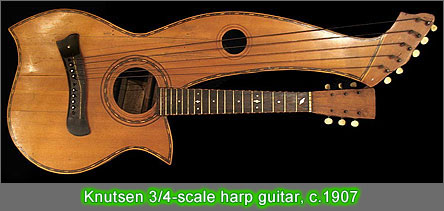 After the 1995 Christmas project, I eventually started on a follow-up:
another “themed” album using not all, but many, of the instruments—ironically
with only one harp guitar piece. I had maybe half of it demoed in
rough form, when the whole “harp guitar thing” happened,
and I simply had to abandon it. In a nutshell, I was thrust into a
position—or took advantage of some serendipitous opportunities
to become by default—the “harp guitar historian,” evolving
eventually into the “harp guitar pope.” Starting in 2003,
very quickly, Stephen Bennett’s Harp Guitar Gathering
happened, I started Harpguitars.net, then Harp Guitar Music, and now
am president of the non-profit Harp Guitar Foundation. Just kill me
now. I don’t have time to play harp guitar, let alone the other
now-200 Miner Museum instruments. Remember, I’m an aerospace
engineer by day, for cryin’ out loud!
After the 1995 Christmas project, I eventually started on a follow-up:
another “themed” album using not all, but many, of the instruments—ironically
with only one harp guitar piece. I had maybe half of it demoed in
rough form, when the whole “harp guitar thing” happened,
and I simply had to abandon it. In a nutshell, I was thrust into a
position—or took advantage of some serendipitous opportunities
to become by default—the “harp guitar historian,” evolving
eventually into the “harp guitar pope.” Starting in 2003,
very quickly, Stephen Bennett’s Harp Guitar Gathering
happened, I started Harpguitars.net, then Harp Guitar Music, and now
am president of the non-profit Harp Guitar Foundation. Just kill me
now. I don’t have time to play harp guitar, let alone the other
now-200 Miner Museum instruments. Remember, I’m an aerospace
engineer by day, for cryin’ out loud!
OK, sorry to vent. Anyway…My wife, Jaci, who, among other things,
runs a pet products business, had been bugging me to write an instrumental
tune for one of our dear-departed dogs—which I finally managed—and
then eventually, some of our other past and current dogs (we have
them instead of children). As I was developing a little repertoire
of these “dog tunes,” and as she was aware of other dog
pieces some of our musical friends had done,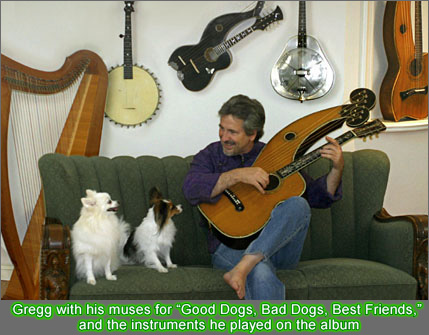 she came up with the idea to do this themed compilation. To make it
come alive, we’d picture each dog, and write a little vignette
of our inspiration. I finally acquiesced and became her co-producer.
By now, I had several tunes, and we realized it was becoming a “Gregg
Miner” album, so we asked our dog-loving friends if they minded
being part of an “…and Friends” project. All said yes.
Mind you, the first was Stephen Bennett. I may be “the pope”
in the HG community, but in the world of harp guitar players,
he’s the king.He not only licensed 3 of his older tunes to us,
but donated a brand new, unreleased harp guitar piece (“Adventure
Dog”). Boy, am I gonna owe him! Another harp guitar
friend, Joe Morgan let me re-mix and use 2 of the 3 dog tunes he did
with hammered dulcimer partner David Moran on their last album. A
couple of other friends—all part of the harp guitar community—asked
or agreed to come up with tunes about current or past canine companions.
We ended up then with a tune each by Frank Doucette (my assistant
in all things harp guitar), Carter Lancaster and Brad Hoyt—the
latter two in the process of releasing their own CD’s through
the label around the same time. Only Carter played harp guitar (Stephen
and Joe having one piece each on the instrument); Brad played a piano
solo, and Frank’s was on 6-string. My own were mostly harp guitar
pieces, that being the instrument I now solely concentrate on, but
I managed to sneak a couple other things in, including the Celtic
harp, which I hadn’t touched in 6-7 years (the acrylic nail conundrum).
It’s my first and only harp solo! But that’s what Maezi
(our latest pooch) demanded. Musically, I mean, not personally.
she came up with the idea to do this themed compilation. To make it
come alive, we’d picture each dog, and write a little vignette
of our inspiration. I finally acquiesced and became her co-producer.
By now, I had several tunes, and we realized it was becoming a “Gregg
Miner” album, so we asked our dog-loving friends if they minded
being part of an “…and Friends” project. All said yes.
Mind you, the first was Stephen Bennett. I may be “the pope”
in the HG community, but in the world of harp guitar players,
he’s the king.He not only licensed 3 of his older tunes to us,
but donated a brand new, unreleased harp guitar piece (“Adventure
Dog”). Boy, am I gonna owe him! Another harp guitar
friend, Joe Morgan let me re-mix and use 2 of the 3 dog tunes he did
with hammered dulcimer partner David Moran on their last album. A
couple of other friends—all part of the harp guitar community—asked
or agreed to come up with tunes about current or past canine companions.
We ended up then with a tune each by Frank Doucette (my assistant
in all things harp guitar), Carter Lancaster and Brad Hoyt—the
latter two in the process of releasing their own CD’s through
the label around the same time. Only Carter played harp guitar (Stephen
and Joe having one piece each on the instrument); Brad played a piano
solo, and Frank’s was on 6-string. My own were mostly harp guitar
pieces, that being the instrument I now solely concentrate on, but
I managed to sneak a couple other things in, including the Celtic
harp, which I hadn’t touched in 6-7 years (the acrylic nail conundrum).
It’s my first and only harp solo! But that’s what Maezi
(our latest pooch) demanded. Musically, I mean, not personally.
Like other Harp Guitar Music compilations, each artist recorded their
piece where and when they could, I did some editing on a couple, then
the great Kim Person (SB’s engineer) and mastering guru Bill
Wolf got things as consistent as possible.
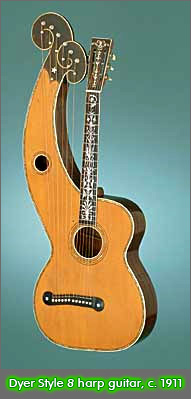
How does this album reflect my style? I don’t know—Don Alder
(fingerstyle champ and harp guitarist) called me “the Frank Zappa
of the harp guitar”—referring to my “unexpected choice
of notes.” Some guitar players respond to it at the Gatherings,
perhaps because there’s a bit of quirkiness in there, along with
a bit of loveliness (I hope!). I can’t judge my own work in the
least, I just do it for my own amusement—and if anyone else can
enjoy it, how wonderful! I definitely am not “background music”!
The point of this project was that I would produce an instrumental
mostly-guitar album for those fans to my best ability, while Jaci
was ensuring that it was entertaining and accessible to the audience
she hopes to reach—the thousands of dog owners/lovers. The goal
is getting instrumental music fans to read the booklet, and dog owners
who should enjoy the booklet to discover our music (“you mean
there aren’t any words”?). Everyone who has actually
sat down and read and listened has laughed and cried, and that
says something.
How did the Harp Guitar label begin and can you say something
about the responsibility of wearing the two hats of artist and label
owner?
At the end of the very first Harp Guitar Gathering in 2003, a couple
of us were brainstorming, and thought “what we need now is a
harp guitar compilation album of all of us.” So we did it. Stephen
Bennett, John Doan and I co-produced Beyond Six Strings, which
was a grass roots “co-op” CD of pretty much all the harp
guitar players who were active at the time and had a great tune (or
wrote one) to include. We got it out just in time for the 2nd (already
annual) Gathering. All 13 players jointly invested, and we sold the
thousand copies, and we pressed another batch, again sharing the costs.
By now there were a lot of great comments about it, and I was really
lamenting the fact that we hadn’t sent it to any radio stations
or a single guitar mag for review, because it had no home.
There was no owner or entity behind this otherwise seminal noteworthy
history-making release!
After some logistical brainstorming with John Doan, who finally agreed
that I would have to be the one to do it (gee, thanks!), I polled
the group of 13, and all agreed to license the master to me, under
newly-created Harp Guitar Music. So in 2006, Beyond Six Strings
became the inaugural Harp Guitar Music record label release. I’m
on my own second printing, and it’s outselling all my other titles
on Amazon.
The perk of being, as you say, both artist and label owner,
is that I can finally get on a damn album without a rejection letter!
The responsibility is that I do have to hold my own with consummate
virtuosos—and with digital editing, I just manage. But seriously,
I also have my assistant Frank Doucette—who has the most reliable
discerning taste in guitar music of anyone alive—approve my compositions,
recordings and final mixes. Believe me, if something is not stellar,
he’d tell me.
Despite the obvious connections we’ve made in the harp guitar
community, we don’t let politics or friendship influence any
musical decisions. Our one and only goal is presenting great music.
Can you say something about how you find the artists featured
on the Harp Guitar Music label such as Philippe Fouquet who comes
all the way from France.
The majority are artists I hear at the Harp Guitar Gatherings. It
helps to have a personal connection—many attendees have become
dear friends—but I also must be personally drawn to their music.
Then the process begins: I try to befriend them, convince them I am
their greatest fan, get them to agree to do an album together, and
then bluntly give these “heroes” my critique on every single
note of their beloved tunes! Well, OK, the process is more subtle
than that, but still, I succeed I suppose because I have great hubris,
but greater passion. I wear my heart on my sleeve, have no control
over my mouth, and if I love something, or not, you’ll know it!
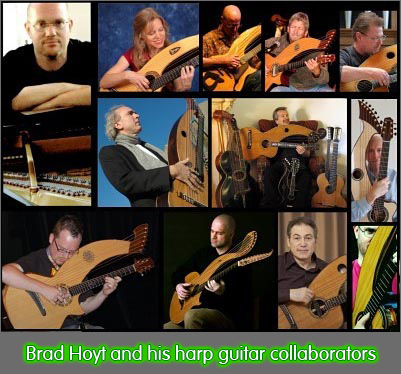
I approached Andy Wahlberg with an album concept that way, and later
Carter Lancaster. His CD—the debut of his incredible harp guitar—is
one of the new releases. Other solo projects with Stacy Hobbs and
Tim Donahue—again, Gathering artists—are still in the works.
Brad Hoyt (the latest release) was this fellow who came to the Gathering
every year from year 2—without owning or playing the instrument!
He was a multi-instrumentalist exploring how to create a unique version
of a harp guitar—and boy, did he ever! It’s on his CD. He
is predominately a pianist and prolific composer, and came up with
the idea of a duet album of piano and harp guitar—various harp
guitars and players pulled from the friends he’d made over the
years. I thought it was a great idea, and we agreed to do it on the
label, and I got to cherry-pick my favorite Brad Hoyt tunes. I did
three, as it was originally just to be a handful of us with 2-3 tunes
each. Almost three years later, the end result instead included a
larger roster of incredible players we got on board. The title, Together
Alone is appropriate as no two players recorded in the same room!
He tried, but schedules and logisitics dictated that each record their
part in his or her own city and country. The back-and-forth arranging
took the most time, but the flawless final collaborations are amazing.
Outside the Gatherings, in my role as editor of Harpguitars.net, I
hear about pretty much everyone out there playing harp guitar. Often,
I’m the first to discover it, or one of our many constituents
stumbles across somebody and sends me a link. We’re always weighing
these new discoveries—those that are starting to perform on the
harp guitar—for possible label projects. Some are aware of Harpguitars.net,
where I collate and archive every last use and appearance of the instrument.
More often, we find and approach them. One easy way for me, as owner
of Harp Guitar Music, is to simply ask each purchaser of strings “Who
are you and what are you doing with harp guitar?”—which
of course interests me both as head of the Harp Guitar Foundation
and Harpguitars.net, and for Harp Guitar Music potential. There are
hundreds of new harp guitar builders, owners and players out
there—but almost to a man (and the occasional woman) they are
initially private and/or shy.
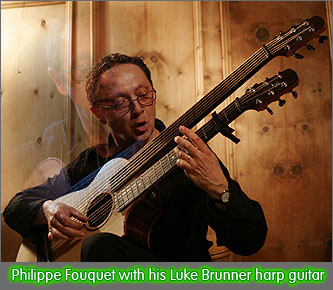 Philippe
is one of the few artists on the label or on our compilations that
I haven’t met. Frank knew him as an interesting 6-string player,
and only found him because he owned a Kathy Wingert guitar as Frank
did. We both liked his music, and that’s always the first step!
The second Frank discovered Philippe owned an old kontragitarre
(Viennese harp guitar), which he eventually recorded one piece
with, we were all over it. We almost got him on “Harp Guitar
Dreams” (“technical guitar difficulties” prevented
his inclusion), and the experience was positive enough (creative discussion
and co-production with little ego) that we mutually agreed to work
together on a full album, provided harp guitar was at least half of
it.
Philippe
is one of the few artists on the label or on our compilations that
I haven’t met. Frank knew him as an interesting 6-string player,
and only found him because he owned a Kathy Wingert guitar as Frank
did. We both liked his music, and that’s always the first step!
The second Frank discovered Philippe owned an old kontragitarre
(Viennese harp guitar), which he eventually recorded one piece
with, we were all over it. We almost got him on “Harp Guitar
Dreams” (“technical guitar difficulties” prevented
his inclusion), and the experience was positive enough (creative discussion
and co-production with little ego) that we mutually agreed to work
together on a full album, provided harp guitar was at least half of
it.
The “co-production” and collaboration between me and an
artist like Philippe is purely musical and creatively fulfilling,
with some necessary practicalities worked out. As a business model,
it’s all but nonsensical in today’s music business reality—an
artist doesn’t really need HGM, and I’m making little or
nothing for my own efforts. So why do we both choose to do it? Simple—for
the love of the music, which in the end, both parties should feel
is stronger from the collaboration. So far, all agree that it is.
Can you mention some of your musical influences, favorite guitarists
and most influential albums?
I’ve never purposely or consciously thought to copy anybody or
sound like anyone else—who would? But on the other hand, when
one is learning, and especially has not yet learned to write (something
I wouldn’t yet claim), one learns to play the music of others
that one likes, and when experimenting on the same instrument, naturally
a lot of those techniques and sounds come out. I suppose a bit of
simplified Kottke was part of my first steel-string fingerstyle technique
(long after listening to him as a god, and only after classical and
other guitar studies). Then as I said earlier—Dave Evans was
someone whose music I just loved, but it was also about the only guitar
finger-style that I found easy to do, yet it sounds impressive! Somehow
it fit my meager talents. An aside: By a strange circle of fate, 30
years later, Dave and I met and become friends. I subsequently arranged
his “Sad Pig Dance” on harp guitar, which he loved. Better
yet, Dave has been listening to, and enjoying the new Dog CD,
and says he hears himself in my playing. I guess that’s your
question answered!
I have plenty of favorite guitarists, from many styles. Frankly, I’m
not interested in guitar technique, or style—only music. Two
of my favorite composers would be Metheny (from the older Group era
- “Combo Americana Jazz” I describe it) and Stephen Bennett
(from the beginning to date). That latter is not a suck-up, I truly
mean it. I love Pierre Bensusan and Jimi Hendrix as so many of us
do, and my favorite bar none has always been Allan Holdsworth. An
influence? Well, yes and no. I couldn’t play electric guitar
like that in a million years—nor ever tried to—but the “gist”
of him inspires me constantly. I don’t mean the speed, which
is neither here nor there, nor his strange, Sci-Fi compositions, most
of which leave me cold. It’s the miracle where he can improvise
a few melodic licks, and somehow—in the space of just a few measures—infuse
them with all the drama, humor, character, and “mind’s ear”
storytelling as Prokofiev’s entire “Peter and the Wolf.”
He does this somewhere on most every album, in one tune or
another. I live for that creative gift. There’s nothing
akin to it—like certain Bennett pieces, the only thing I can
think of are the Impressionists—Debussy, Satie, Poulenc, Ravel,
et al. They created this “color” and ear-candy exoticism
perhaps intellectually and deliberately, but to the same end. ‘melodic
storytelling.’ (Yes, they’re my favorite composers if you
couldn’t guess) Favorite 3 albums if stuck on a desert island?
The 3 Bothy Band studio albums. Of course, I listen to everything
by Bela Fleck and have never gotten over that first Bulgarian Women’s
Chorus album way back. I could go on all day. I don’t know if
there’s any thematic pattern here or not! Or influence. I hope
so, but I hope not—I wish I could pull off something
one percent as wonderful that’s just pure me. Wouldn’t that
be something?
Thanks Gregg, in closing can you fill in the readers about current
and upcoming plans regarding your recordings, new recording sessions,
upcoming tours and performances? And how about future plans for the
Harp guitar record label as well?
My own recordings? Thanks for asking. Well, I’ve got a
pile of grandiose, spectacular albums in my head... I’ll try
to chip away at one or another while I meanwhile blatantly insert
myself into every group harp guitar production I develop. At least
until I find a way to kick myself off. Sadly, I never tour, and rarely
perform. I simply don’t have the time! Once in awhile, you might
catch me at some special event, and I’m always busting my you-know-what
to prep for our annual Harp Guitar Gatherings. 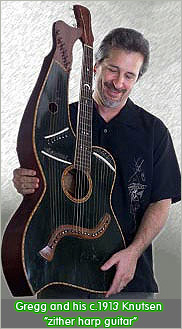
As for Harp Guitar Music releases, the hope was—remember this
is one part-time job of many—to do at least one release a year
if cash-flow allows. By coincidence, four new long-time-in-the-making
releases just happened to finish up at the same time: mine, Philippe
Fouquet’s (Turning Point), Carter Lancaster’s (Case
Closed), and now Brad Hoyt’s (Together Alone).
I consider all these “firsts”—either in presenting
a new concept or the artist’s first harp guitar record.
I’ve got at least ten “concept album” compilations
in the pipeline and will try to enlist some of the “usual suspects”
and hopefully more new players. I’ve got material myself for
some of these already. The goal is for certain special releases to
be all-new material, while others may be collections. I won’t
jinx any by announcing them. They usually evolve organically and randomly—and
then really quickly. For instance, the previous Harp Guitar
Dreams compilation developed when it did, in the way it did, only
because Alex de Grassi had borrowed this outrageous Fred Carlson harp-sympitar
to do a big Healdsburg Guitar Festival demo, and in those short couple
months got some material recorded. As Alex was, by my great fortune,
yet another guitar idol I got to befriend, I had been bugging him
to get into the instrument—and if he ever did, well, “gosh,
a track sure would be nice…” I figured that might be our
one and only chance—and when he agreed, the call went out: we’re
doing a new compilation, now! And what a stunning track - and concept
album—it turned out to be.
In the end, there are already enough exciting harp guitar projects
to fill up the rest of my years. And we are just getting started!
The “movement” has been slowly but exponentially growing,
and next year will see an explosion of new players when the first
quality Chinese Dyer harp guitar copies hit the market. I kid you
not: Holloway Harp Guitars. Just think what would happen if one of
these ended up in the hands of a John Mayer, or a Dave Matthews or
someone like that!
www.HarpGuitarMusic.com
/ www.BradHoyt.com
/ www.CarterLancaster.com
www.MinerMusic.com
/ www.PhilippeFouquet.com
www.HarpGuitar.fr / www.TwoLittleDogs.com



